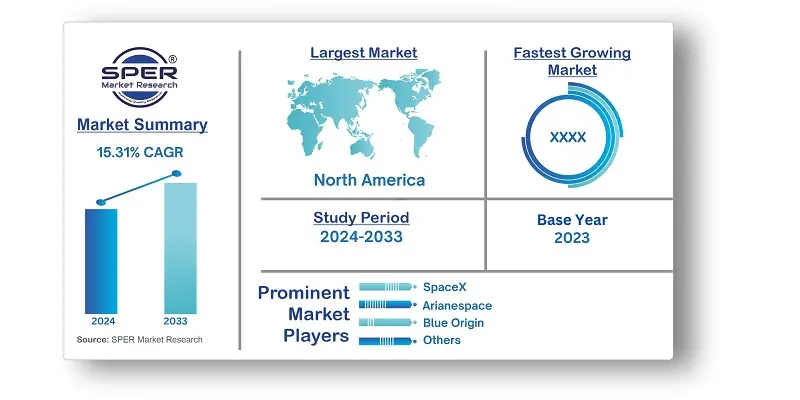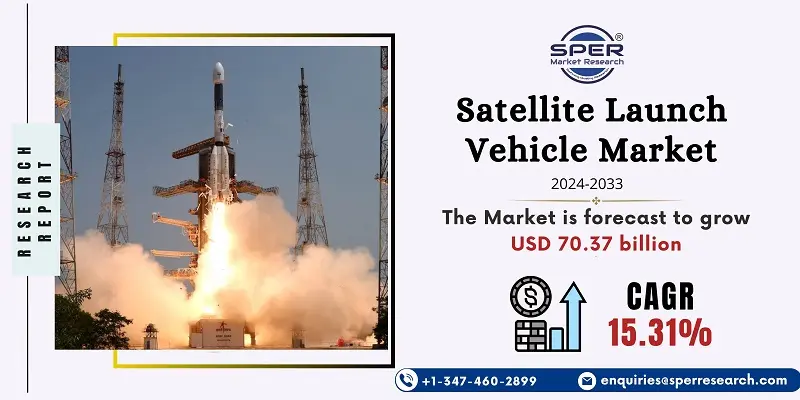
Satellite Launch Vehicle Market Growth, Size, Trends, Demand, Share, Revenue and Future Outlook
Satellite Launch Vehicle Market Size- By Vehicle, By Payload, By Orbit, By Launch, By Stage, By Subsystem- Regional Outlook, Competitive Strategies and Segment Forecast to 2033
| Published: Apr-2024 | Report ID: AERO2413 | Pages: 1 - 233 | Formats*: |
| Category : Aerospace and Defence | |||
- March 2023; ISRO deployed 36 communication satellites of Oneweb aboard its LVM3 rocket into LEO.
- August 2022; The Atlas V rocket launched from the Cape Canaveral Space Force Station, carrying SBIRS GEO-6, which was constructed by Lockheed Martin for the US Air Force.


| Report Metric | Details |
| Market size available for years | 2020-2033 |
| Base year considered | 2023 |
| Forecast period | 2024-2033 |
| Segments covered | By Vehicle, By Payload, By Orbit, By Launch, By Stage, By Subsystem |
| Regions covered | North America, Asia-Pacific, Latin America, Middle East & Africa and Europe |
| Companies Covered | SpaceX, Arianespace, United Launch Alliance, Roscosmos, Blue Origin, China Aerospace Science and Technology Corporation, Mitsubishi Heavy Industries, Indian Space Research Organisation, Eurockot Launch Services & Virgin Orbit. |
- Educational Institutions
- Government Agencies
- Investors
- Manufacturers
- Media
- Military
- Regulatory Bodies
- Research Institutions
- Satellite Operators
- Space Exploration Companies
| By Vehicle: |
|
| By Payload: |
|
| By Orbit: |
|
| By Launch: |
|
| By Stage: |
|
| By Subsystem: |
|
- Global Satellite Launch Vehicle Market Size (FY’2024-FY’2033)
- Overview of Global Satellite Launch Vehicle Market
- Segmentation of Global Satellite Launch Vehicle Market By Vehicle (Small <350,000 kg, Medium to Heavy >350,000 kg)
- Segmentation of Global Satellite Launch Vehicle Market By Payload(<500 kg, 500-2,500kg, >2500 kg)
- Segmentation of Global Satellite Launch Vehicle Market By Orbit(Low Earth Orbit (LOE), Medium Earth Orbit(MEO), Geostationary Orbit (GEO))
- Segmentation of Global Satellite Launch Vehicle Market By Launch (Single – use/Expendable, Reusable)
- Segmentation of Global Satellite Launch Vehicle Market By Stage(Single Stage, Two Stage, Three Stage)
- Segmentation of Global Satellite Launch Vehicle Market By Subsystem(Structure, Guidance, Navigation & Control System, Propulsion Systems, Telemetry, Tracking & Command Systems, Electrical, Separation Systems)
- Statistical Snap of Global Satellite Launch Vehicle Market
- Expansion Analysis of Global Satellite Launch Vehicle Market
- Problems and Obstacles in Global Satellite Launch Vehicle Market
- Competitive Landscape in the Global Satellite Launch Vehicle Market
- Impact of COVID-19 and Demonetization on Global Satellite Launch Vehicle Market
- Details on Current Investment in Global Satellite Launch Vehicle Market
- Competitive Analysis of Global Satellite Launch Vehicle Market
- Prominent Players in the Global Satellite Launch Vehicle Market
- SWOT Analysis of Global Satellite Launch Vehicle Market
- Global Satellite Launch Vehicle Market Future Outlook and Projections (FY’2023-FY’2033)
- Recommendations from Analyst
1.1. Scope of the report1.2. Market segment analysis
2.1. Research data source2.1.1. Secondary Data2.1.2. Primary Data2.1.3. SPER’s internal database2.1.4. Premium insight from KOL’s2.2. Market size estimation2.2.1. Top-down and Bottom-up approach2.3. Data triangulation
4.1. Driver, Restraint, Opportunity and Challenges analysis4.1.1. Drivers4.1.2. Restraints4.1.3. Opportunities4.1.4. Challenges4.2. COVID-19 Impacts of the Global Satellite Launch Vehicle Market
5.1. SWOT Analysis5.1.1. Strengths5.1.2. Weaknesses5.1.3. Opportunities5.1.4. Threats5.2. PESTEL Analysis5.2.1. Political Landscape5.2.2. Economic Landscape5.2.3. Social Landscape5.2.4. Technological Landscape5.2.5. Environmental Landscape5.2.6. Legal Landscape5.3. PORTER’s Five Forces5.3.1. Bargaining power of suppliers5.3.2. Bargaining power of buyers5.3.3. Threat of Substitute5.3.4. Threat of new entrant5.3.5. Competitive rivalry5.4. Heat Map Analysis
6.1. Global Satellite Launch Vehicle Market Manufacturing Base Distribution, Sales Area, Product Type6.2. Mergers & Acquisitions, Partnerships, Product Launch, and Collaboration in Global Satellite Launch Vehicle Market
7.1. Global Satellite Launch Vehicle Market Value Share and Forecast, By Vehicle, 2024-20337.2. Small <350,000 kg7.3. Medium to Heavy >350,000 kg
8.1. Global Satellite Launch Vehicle Market Value Share and Forecast, By Payload, 2024-20338.2. <500 kg8.3. 500-2,500kg8.4. >2500 kg
9.1. Global Satellite Launch Vehicle Market Value Share and Forecast, By Orbit, 2024-20339.2. Low Earth Orbit (LOE)9.3. Medium Earth Orbit(MEO)9.4. Geostationary Orbit (GEO)
10.1. Global Satellite Launch Vehicle Market Value Share and Forecast, By Launch, 2024-203310.2. Single – use/Expendable10.3. Reusable
11.1. Global Satellite Launch Vehicle Market Value Share and Forecast, By Stage, 2024-203311.2. Single Stage11.3. Two Stage11.4. Three Stage
12.1. Global Satellite Launch Vehicle Market Value Share and Forecast, By Subsystem, 2024-203312.2. Structure12.3. Guidance12.4. Navigation & Control System12.5. Propulsion Systems12.6. Telemetry12.7. Tracking & Command Systems12.8. Electrical12.9. Separation Systems
13.1. Global Satellite Launch Vehicle Market Size and Market Share
14.1. Global Satellite Launch Vehicle Market Size and Market Share By Vehicle (2020-2026)14.2. Global Satellite Launch Vehicle Market Size and Market Share By Vehicle (2027-2033)
15.1. Global Satellite Launch Vehicle Market Size and Market Share By Payload (2020-2026)15.2. Global Satellite Launch Vehicle Market Size and Market Share By Payload (2027-2033)
16.1. Global Satellite Launch Vehicle Market Size and Market Share By Orbit (2020-2026)16.2. Global Satellite Launch Vehicle Market Size and Market Share By Orbit (2027-2033)
17.1. Global Satellite Launch Vehicle Market Size and Market Share By Launch (2020-2026)17.2. Global Satellite Launch Vehicle Market Size and Market Share By Launch (2027-2033)
18.1. Global Satellite Launch Vehicle Market Size and Market Share By Stage (2020-2026)18.2. Global Satellite Launch Vehicle Market Size and Market Share By Stage (2027-2033)
19.1. Global Satellite Launch Vehicle Market Size and Market Share By Subsystem (2020-2026)19.2. Global Satellite Launch Vehicle Market Size and Market Share By Subsystem (2027-2033)
20.1. Global Satellite Launch Vehicle Market Size and Market Share By Region (2020-2026)20.2. Global Satellite Launch Vehicle Market Size and Market Share By Region (2027-2033)
20.3. Asia-Pacific20.3.1. Australia20.3.2. China20.3.3. India20.3.4. Japan20.3.5. South Korea20.3.6. Rest of Asia-Pacific20.4. Europe20.4.1. France20.4.2. Germany20.4.3. Italy20.4.4. Spain20.4.5. United Kingdom20.4.6. Rest of Europe20.5. Middle East and Africa20.5.1. Kingdom of Saudi Arabia20.5.2. United Arab Emirates20.5.3. Rest of Middle East & Africa20.6. North America20.6.1. Canada20.6.2. Mexico20.6.3. United States20.7. Latin America20.7.1. Argentina20.7.2. Brazil20.7.3. Rest of Latin America
21.1. Arianespace21.1.1. Company details21.1.2. Financial outlook21.1.3. Product summary21.1.4. Recent developments21.2. Blue Origin21.2.1. Company details21.2.2. Financial outlook21.2.3. Product summary21.2.4. Recent developments21.3. China Aerospace Science and Technology Corporation21.3.1. Company details21.3.2. Financial outlook21.3.3. Product summary21.3.4. Recent developments21.4. Eurockot Launch Services21.4.1. Company details21.4.2. Financial outlook21.4.3. Product summary21.4.4. Recent developments21.5. Indian Space Research Organisation21.5.1. Company details21.5.2. Financial outlook21.5.3. Product summary21.5.4. Recent developments21.6. Mitsubishi Heavy Industries21.6.1. Company details21.6.2. Financial outlook21.6.3. Product summary21.6.4. Recent developments21.7. Roscosmos21.7.1. Company details21.7.2. Financial outlook21.7.3. Product summary21.7.4. Recent developments21.8. SpaceX21.8.1. Company details21.8.2. Financial outlook21.8.3. Product summary21.8.4. Recent developments21.9. United Launch Alliance21.9.1. Company details21.9.2. Financial outlook21.9.3. Product summary21.9.4. Recent developments21.10. Virgin Orbit21.10.1. Company details21.10.2. Financial outlook21.10.3. Product summary21.10.4. Recent developments21.11. Others
SPER Market Research’s methodology uses great emphasis on primary research to ensure that the market intelligence insights are up to date, reliable and accurate. Primary interviews are done with players involved in each phase of a supply chain to analyze the market forecasting. The secondary research method is used to help you fully understand how the future markets and the spending patterns look likes.
The report is based on in-depth qualitative and quantitative analysis of the Product Market. The quantitative analysis involves the application of various projection and sampling techniques. The qualitative analysis involves primary interviews, surveys, and vendor briefings. The data gathered as a result of these processes are validated through experts opinion. Our research methodology entails an ideal mixture of primary and secondary initiatives.



Frequently Asked Questions About This Report
PLACE AN ORDER
Year End Discount
Sample Report
Pre-Purchase Inquiry
NEED CUSTOMIZATION?
Request CustomizationCALL OR EMAIL US
100% Secure Payment






Related Reports
Our Global Clients
Our data-driven insights have influenced the strategy of 200+ reputed companies across the globe.




















